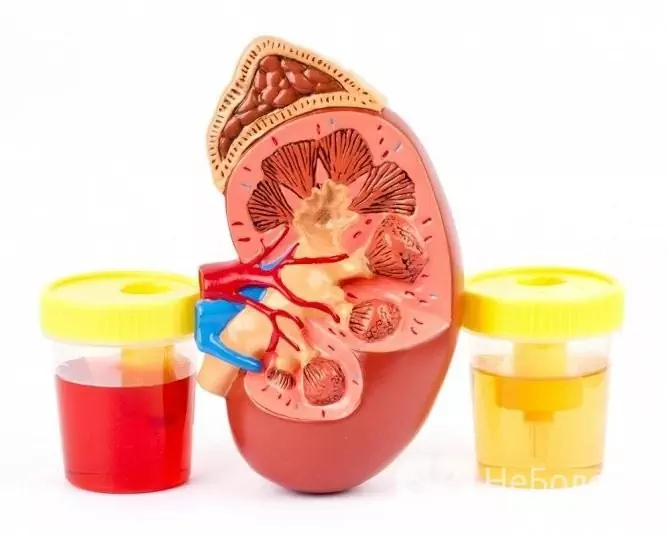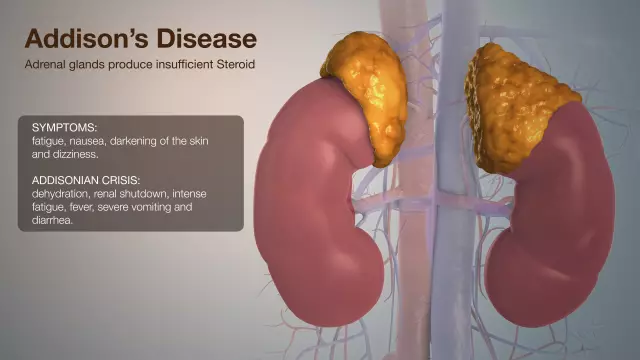- Author Rachel Wainwright [email protected].
- Public 2023-12-15 07:39.
- Last modified 2025-11-02 20:14.
Gunther's disease
The content of the article:
- Causes and risk factors
- Symptoms
- Diagnostics
- Treatment
- Possible complications and consequences
- Forecast
- Prevention
Gunther's disease (congenital erythropoietic porphyria) is a rare hereditary disease in which pigment metabolism is impaired and a nitrogen-containing pigment (porphyrin) accumulates in the tissues. With this disease in the later stages, the appearance of the patients is disfigured.
Gunther's disease occurs in 1 person in 1,000,000 newborns. The incidence rate is slightly higher among the rural population of Transylvania. Scientists explain this fact by the fact that closely related marriages are still common in the named region.
Attention! Photo of shocking content.
Click on the link to view.
Causes and risk factors
Gunther's disease is a genetic disorder inherited in an autosomal recessive manner, that is, for it to occur, the child must receive an altered gene from both the mother and the father. At the same time, the parents of the sick child are healthy, but they are carriers of the mutated gene.
The mutation that causes the development of congenital erythropoietic porphyria is localized at the 10q26.1-q26.2 locus of the long arm of chromosome 10. It leads to a deficiency of the enzyme uroporphyrinogen III synthase, as a result of which heme metabolism is disrupted, and the photosensitivity of the skin is also significantly increased.

More often children with Gunther's disease are born in countries where closely related marriages are practiced
The main factor that increases the risk of having a child with Gunther's disease is closely related marriages.
Symptoms
In most cases, Gunther's disease manifests itself in sick children already in the first year of life. Her symptoms:
- red-bloody urine;
- increased hair growth (hypertrichosis);
- high tissue photosensitivity;
- staining teeth red (erythrodontia);
- hemolytic anemia;
- enlargement of the spleen, and in some cases the liver.

You can suspect Gunther's disease in a child by the red-bloody color of urine
In the later stages of the disease, the appearance of patients is disfigured beyond recognition. Their faces are covered with ulcers. The skin in the paraoral area dries up and hardens, leading to deformation of the lips and exposure of the reddish-brown incisors.
The high photosensitivity of the skin to ultraviolet radiation, which can cause severe burns, causes patients to try to stay in a room with darkened windows during the day, being active at night.

High photosensitivity of the skin leads to fear of light and nocturnal lifestyle
Eating spicy foods, including garlic, causes painful sensations in the altered areas of the skin.
All these signs formed the basis of numerous legends about vampires - terrible creatures who go out at night to drink blood and are afraid of garlic.
Diagnostics
Diagnosis of Gunther's disease is based on the characteristic clinical picture and family history. To confirm the diagnosis, a number of laboratory tests are performed to determine the content of porphyrins and erythrocytes in the blood.
Treatment
Gunther's disease is incurable, therapy is aimed at alleviating the symptoms:
- Protection of the skin from sunlight. To do this, during daylight hours, patients must constantly wear special sun-protective clothing, and also lubricate exposed areas of the body with sunscreen, which includes reflective agents (titanium dioxide, zinc oxide).
- Taking cholestyramine, activated carbon, beta-carotene. These substances make it possible to interrupt the reabsorption of porphyrins, but for this they must be taken in high doses, which leads to the development of side effects (interruption of therapy and correction will be required).
- Blood transfusion. Transfusion of erythrocyte mass and whole blood improves the condition of patients for some time. The limitation is that a regular blood transfusion regimen carries the risk of developing dangerous complications.
- Splenectomy. Removal of the spleen can reduce the severity of hemolytic anemia. However, the effect of this operation does not last long, and after a while the breakdown of red blood cells resumes.
- Taking ascorbic acid (vitamin C) and alpha-tocopherol (vitamin E). These vitamins have powerful antioxidant effects. Their purpose allows you to slow down the rate of damage to the tissues of the patient's body by free radicals.

High doses of activated carbon can interrupt the reabsorption of porphins in Gunther's disease
The scientific literature describes several cases of successful use of transplantation (transplantation) of red bone marrow and stem cells. However, the long-term results of this method in relation to Gunther's disease are unknown.
Possible complications and consequences
In patients with Gunther's disease, the structures of the eye are often damaged, which subsequently leads to a significant deterioration in visual function up to its complete loss, that is, blindness.
Forecast
The prognosis for Gunther's disease is poor. Most patients die before adolescence.
Prevention
There is no specific prevention of the onset of Gunther's disease. Close marriages should be avoided. At the birth of a sick child, as well as in the presence of cases of this disease among close relatives, the married couple should be sent for medical and genetic counseling.
YouTube video related to the article:

Elena Minkina Doctor anesthesiologist-resuscitator About the author
Education: graduated from the Tashkent State Medical Institute, specializing in general medicine in 1991. Repeatedly passed refresher courses.
Work experience: anesthesiologist-resuscitator of the city maternity complex, resuscitator of the hemodialysis department.
The information is generalized and provided for informational purposes only. At the first sign of illness, see your doctor. Self-medication is hazardous to health!






